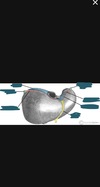Anatomy - The Liver and Gallbladder Flashcards
Give 4 functions of the liver.
- Synthesis of bile. 2. Glycogen storage. 3. Clotting factor production. 4. Detoxification of blood.
What is the liver an embryological derivative of and in which mesentery does it develop?
Derivative of the foregut. Develops in the ventral mesentery.
What structure(s) lie anterior to the liver?
The rib cage and the anterior abdominal wall.
What structure(s) lie superior to the liver?
The diaphragm.
What structure(s) lie posterior to the liver?
Oesophagus, stomach, gall bladder, first part of duodenum. (All are foregut derived organs).
What aspects of the liver does the diaphragmatic surface refer to?
The anterior superior aspects. This surface is smooth and convex.
What aspects of the liver does the visceral surface refer to?
The posterior inferior aspects. It is moulded by the shape of surrounding organs and so is irregular.
Name the 5 liver ligaments.
- The falciform ligament. 2. The right and left coronary ligaments. 3. The right and left triangular ligaments.
What is the function of the falciform ligament?
To attach the liver to the anterior abdominal wall.
What is found in the free edge of this ligament?
The ligamentum teres (remnant of the umbilical vein).
What is the function of the coronary and triangular ligaments?
They attach the superior surface of the diaphragm to the liver.
Name the 4 lobes of the liver.
- Right. 2. Left. 3. Caudate. 4. Quadrate.
What structures bind the Caudate lobe and where is it located?
The IVC and a fossa produced by the ligamentum venosum. It is located on the upper aspect of the right lobe on the visceral surface.
What structures bind the Quadrate lobe and where is it located?
The gall bladder and a fossa produced by the ligamentum teres. It is located on the lower aspect of the right lobe on the visceral surface.
What divides the liver into the right and left lobes?
The falciform ligament.
What vein supplies the liver with dexoygenated blood?
The hepatic portal vein.
What vein supplies the liver with oxygenated blood?
The hepatic artery proper.
What is the function of the gall bladder?
A temporary storage for bile.
What is the storage capacity of the gall bladder?
30-50ml.
What are the 3 divisions of the gall bladder?
Fundus, body and neck. The neck is where the gall bladder tapers and becomes continuous with the cystic duct.
Briefly describe the biliary tree.
Left and right hepatic ducts = common hepatic duct. Common hepatic duct + cystic duct = common bile duct. Common bile duct + pancreatic duct = hepatopancreatic ampulla of Vater.
What is it called where the common bile duct and pancreatic duct meet?
The hepatopancreatic ampulla of Vater.
What is the orifice called where bile empties into the duodenum?
The major duodenal papilla.
What sphincter regulates the emptying of bile into the duodenum?
The sphincter of Oddi.






